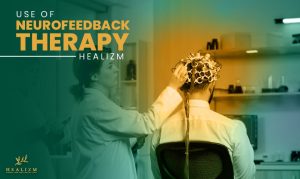
Do you ever feel like you’re stuck in a cycle of negative thoughts or behaviors that you just can’t seem to break? Do you struggle with anxiety, depression, ADHD, or other mental health conditions that make it difficult to enjoy life to the fullest? If so, you’re not alone. Mental health issues can affect anyone at any stage of life and can be debilitating. But the good news is that there is hope.
Neurofeedback therapy is a type of therapy that involves monitoring and training brain waves to improve mental health.
In this blog post, we’ll explore neurofeedback therapy, how it works, and the various conditions it can treat. Read on to discover more about this promising approach to mental health treatment.
What is Neurofeedback Therapy?
Neurofeedback therapy is a non-invasive, drug-free approach to mental health that uses Electroencephalography (EEG) technology to measure brain wave activity. During a neurofeedback session, electrodes are attached to the scalp and connected to a computer, which provides feedback on brain wave patterns. This feedback allows the person to learn how to regulate their brain waves in a way that can improve their mental health.
How Does Neurofeedback Therapy Work?
Neurofeedback therapy is a type of biofeedback that uses real-time displays of brain activity; measured as brain waves. The therapy uses EEG (electroencephalogram) technology to monitor the brain’s activity and provide feedback to the individual through visual or auditory cues.
The brain produces four primary types of brainwaves, each associated with different mental states and activities. These are:
- Delta Waves: These are the slowest brainwaves and are associated with deep sleep and unconsciousness.
- Theta Waves: These waves are associated with the dream state, creativity, and deep relaxation.
- Alpha Waves: These are associated with relaxation, meditation, and a calm, focused mind.
- Beta Waves: These are associated with active thinking, problem-solving, and concentration.
During neurofeedback therapy, the therapist places electrodes on the scalp to monitor the brain’s electrical activity. The patient then performs specific mental exercises, such as deep breathing or visualization, while receiving feedback from the EEG machine through visual or auditory cues. These cues are designed to reward the brain when it produces the desired brainwaves, such as alpha or beta waves, and inhibit the brainwaves associated with negative mental states, such as anxiety or depression.
Over time, the brain learns to produce the desired brainwaves more consistently, leading to lasting changes in brain function and behavior. As a result, individuals who receive neurofeedback therapy may experience reduced symptoms associated with several conditions, including anxiety, neurofeedback therapy for depression, ADHD, PTSD, and more.
What is Neurofeedback Therapy Used to Treat?
Neurofeedback therapy has been used to treat a wide variety of conditions, including:
Depression and Anxiety
Depression and anxiety are two of the most common mental health conditions, and they can significantly impact a person’s quality of life. Neurofeedback therapy is effective in reducing symptoms of depression and anxiety by regulating the brainwave patterns that are associated with these conditions. Neurofeedback therapy can promote relaxation, reduce stress and improve mood by teaching the brain to produce more alpha and fewer beta waves.
ADD and ADHD
Attention deficit disorder (ADD) and attention deficit hyperactivity disorder (ADHD) can make it difficult for individuals to focus, pay attention, and control impulsive behavior. Neurofeedback therapy can help individuals with ADD and ADHD improve their focus and attention by regulating their brainwave patterns. It can improve their cognitive function, reduce distractibility, and improve their performance in daily tasks.
Post-Traumatic Stress Disorder (PTSD)
PTSD is a complex disorder that can be challenging to treat using traditional methods. However, neurofeedback therapy has shown promise as a complementary or alternative treatment approach. By monitoring and training the brainwaves associated with PTSD, neurofeedback therapy can help people with PTSD to reduce their symptoms, such as flashbacks and hypervigilance, and improve their emotional regulation.
Seizure Disorders
Seizure disorders, such as epilepsy, can be debilitating for individuals and may limit their ability to carry out daily tasks. Neurofeedback therapy effectively reduces the frequency and intensity of seizures in individuals with seizure disorders. Neurofeedback therapy can help reduce the abnormal electrical activity in the brain that leads to seizures.
Panic Attacks
Panic attacks can be a frightening and overwhelming experience and can significantly impact a person’s quality of life. Neurofeedback therapy may help reduce the frequency and intensity of panic attacks by regulating the brainwave patterns associated with anxiety. Neurofeedback therapy can promote relaxation, reduce stress, and improve mood, reducing the frequency and intensity of panic attacks.
Insomnia
Insomnia is a common sleep disorder that can significantly impact a person’s quality of life. Neurofeedback therapy can help individuals with insomnia improve their sleep quality by promoting relaxation and regulating their brainwave patterns. Neurofeedback therapy can help promote relaxation, reduce stress, and improve sleep quality.
Traumatic Brain Injury (TBI)
Traumatic brain injury can significantly impair a person’s cognitive function and ability to carry out daily tasks. Neurofeedback therapy can help individuals with TBI improve their cognitive function and reduce symptoms such as headaches, dizziness, and fatigue.
The Benefits of Neurofeedback Therapy
There are many benefits to neurofeedback therapy, including:
- Non-invasive: Neurofeedback therapy is non-invasive and does not require medication, making it a safe and effective option for individuals who prefer a more natural approach to mental and physical health.
- Personalized: Neurofeedback therapy is personalized to each person’s brain wave patterns and needs, allowing for a more targeted and effective treatment approach.
- Effective: Research has shown that neurofeedback therapy is effective in treating various conditions and can result in lasting changes in brain function and behavior.
- Safe: Neurofeedback therapy is a safe treatment option with minimal risk of side effects, making it a viable option for individuals of all ages and health conditions.
- Versatile: Neurofeedback therapy can be used as a standalone treatment or in combination with other therapies, making it a versatile treatment option for many conditions.
Contact Healizm Today
At Healizm, we understand that seeking help for mental health can be daunting, so we strive to make the process as convenient and comfortable as possible. If you’re ready to take the first step towards a healthier and happier you, or if you’re curious about the potential benefits of neurofeedback therapy, we invite you to reach out to us through our online form or by giving us a call at (888) 871-0137. Don’t let fear hold you back; leap to a better you with Healizm.
In addition to neurofeedback therapy, we offer various other mental health services, including therapy, counseling, and medication management. We aim to provide our clients with a comprehensive and personalized approach to mental health care specific to their unique needs.
